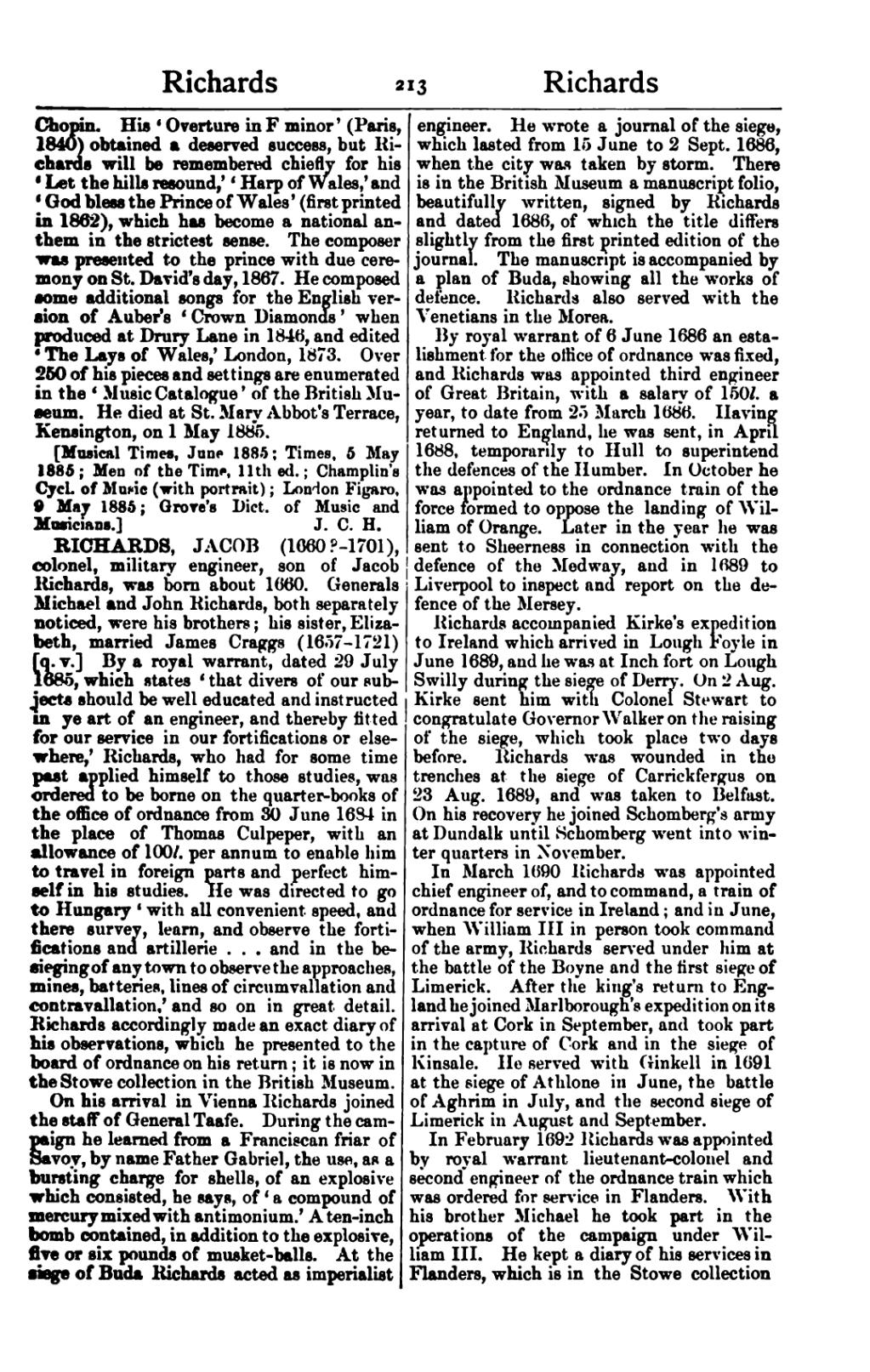Chopin. His ‘Overture in F minor’ (Paris, 1840) obtained a deserved success, but Richards will be remembered chiefly for his ‘Let the hills resound,’ ‘Harp of Wales,’ and ‘God bless the Prince of Wales’ (first printed in 1862), which has become a national anthem in the strictest sense. The composer was presented to the prince with due ceremony on St. David's day, 1867. He composed some additional songs for the English version of Auber's ‘Crown Diamonds’ when produced at Drury Lane in 1846, and edited ‘The Lays of Wales,’ London, 1873. Over 250 of his pieces and settings are enumerated in the ‘Music Catalogue’ of the British Museum. He died at St. Mary Abbot's Terrace, Kensington, on 1 May 1885.
[Musical Times, June 1885; Times, 5 May 1885; Men of the Time, 11th ed.; Champlin's Cycl. of Music (with portrait); London Figaro, 9 May 1885; Grove's Dict. of Music and Musicians.]
RICHARDS, JACOB (1660?–1701), colonel, military engineer, son of Jacob Richards, was born about 1660. Generals Michael [q. v.] and John Richards [q. v.], both separately noticed, were his brothers; his sister, Elizabeth, married James Craggs (1657–1721) [q. v.] By a royal warrant, dated 29 July 1685, which states ‘that divers of our subjects should be well educated and instructed in ye art of an engineer, and thereby fitted for our service in our fortifications or elsewhere,’ Richards, who had for some time past applied himself to those studies, was ordered to be borne on the quarter-books of the office of ordnance from 30 June 1684 in the place of Thomas Culpeper, with an allowance of 100l. per annum to enable him to travel in foreign parts and perfect himself in his studies. He was directed to go to Hungary ‘with all convenient speed, and there survey, learn, and observe the fortifications and artillerie … and in the besieging of any town to observe the approaches, mines, batteries, lines of circumvallation and contravallation,’ and so on in great detail. Richards accordingly made an exact diary of his observations, which he presented to the board of ordnance on his return; it is now in the Stowe collection in the British Museum.
On his arrival in Vienna Richards joined the staff of General Taafe. During the campaign he learned from a Franciscan friar of Savoy, by name Father Gabriel, the use, as a bursting charge for shells, of an explosive which consisted, he says, of ‘a compound of mercury mixed with antimonium.’ A ten-inch bomb contained, in addition to the explosive, five or six pounds of musket-balls. At the siege of Buda Richards acted as imperialist engineer. He wrote a journal of the siege, which lasted from 15 June to 2 Sept. 1686, when the city was taken by storm. There is in the British Museum a manuscript folio, beautifully written, signed by Richards and dated 1686, of which the title differs slightly from the first printed edition of the journal. The manuscript is accompanied by a plan of Buda, showing all the works of defence. Richards also served with the Venetians in the Morea.
By royal warrant of 6 June 1686 an establishment for the office of ordnance was fixed, and Richards was appointed third engineer of Great Britain, with a salary of 150l. a year, to date from 25 March 1686. Having returned to England, he was sent, in April 1688, temporarily to Hull to superintend the defences of the Humber. In October he was appointed to the ordnance train of the force formed to oppose the landing of William of Orange. Later in the year he was sent to Sheerness in connection with the defence of the Medway, and in 1689 to Liverpool to inspect and report on the defence of the Mersey.
Richards accompanied Kirke's expedition to Ireland which arrived in Lough Foyle in June 1689, and he was at Inch fort on Lough Swilly during the siege of Derry. On 2 Aug. Kirke sent him with Colonel Stewart to congratulate Governor Walker on the raising of the siege, which took place two days before. Richards was wounded in the trenches at the siege of Carrickfergus on 23 Aug. 1689, and was taken to Belfast. On his recovery he joined Schomberg's army at Dundalk until Schomberg went into winter quarters in November.
In March 1690 Richards was appointed chief engineer of, and to command, a train of ordnance for service in Ireland; and in June, when William III in person took command of the army, Richards served under him at the battle of the Boyne and the first siege of Limerick. After the king's return to England he joined Marlborough's expedition on its arrival at Cork in September, and took part in the capture of Cork and in the siege of Kinsale. He served with Ginkell in 1691 at the siege of Athlone in June, the battle of Aghrim in July, and the second siege of Limerick in August and September.
In February 1692 Richards was appointed by royal warrant lieutenant-colonel and second engineer of the ordnance train which was ordered for service in Flanders. With his brother Michael he took part in the operations of the campaign under William III. He kept a diary of his services in Flanders, which is in the Stowe collection
